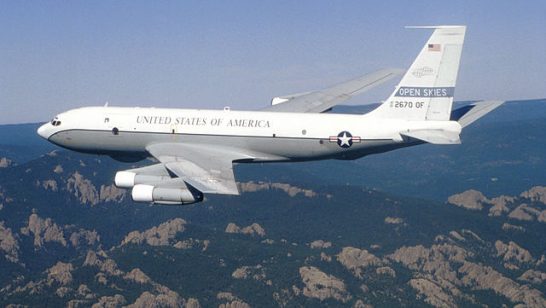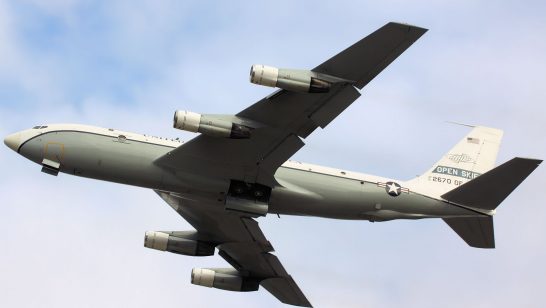
A little less than a year ago, on 6 December 2018, a military Boeing wide-body jet took to the skies over Ukraine. As the US Air Force crew brought the aircraft to cruising altitude, observers from the United States, Canada, Germany, France, Romania, Ukraine and the United Kingdom, settled in for the journey.
This was not an ordinary flight. It came about after an exchange of gunfire and the Russian seizure of three Ukrainian ships trying to transit the Kerch Strait, a narrow strip of water connecting the Black Sea with the Sea of Azov, on 27 November 2018. The United States’ Department of Defense stated that the flight was a reaffirmation of its “commitment to Ukraine and other partner nations” as well as a display of its resolute “support for the security of European nations.”
But the US Airforce was not about to unlawfully trespass into Ukrainian or Russian airspace. Instead, it was on an “extraordinary observation flight,” facilitated by the 1992 Treaty on Open Skies, without which this exceptional display of support could not have occurred.
On 27 October 2019, the Wall Street Journal reported that President Trump had already signed a letter signalling the United States’ intention to withdraw from the Treaty. Critics of the Treaty believe that a withdrawal would strengthen US security. More likely, it would weaken its position by both denying its allies a valuable monitoring tool, and itself the ability to demonstrate US presence by physically flying over the territory of a strategic rival.
What is the Treaty on Open Skies?
The Open Skies Treaty, which entered into force in 2002 and covers 34 countries, was developed so that parties to the agreement could improve their security relations and avoid misperceptions that might lead to military escalation. The Treaty is without specific arms control prohibitions, but instead enables fair aerial observation of anything that a state party so desires, and it has a significant geographical reach to boot (ranging from ‘Vancouver to Vladivostok’).
Those involved in preparing for and flying Open Skies missions see ongoing value in the military-to-military interaction they have with their counterparts, and such interactions are becoming increasingly rare in other areas. This view has ensured that the agreement, for the most part, operates on a business as usual basis. However, treaty implementation has become increasingly subject to stop-and-start. For instance, since the Russian annexation of Crimea, states parties refrain from flying over it, as doing this with Russian host crews would be seen as a recognition of the annexation. Moreover, since its recognition of Abkhazia as an independent state, Russia does not approve flight plans that get closer than 10 km to the border of Abkhazia. Georgia has responded by not allowing Russian flights over its territory. In return, the United States has taken ‘reasonable and comparable’ countermeasures, by for instance restricting flights over part of the American continent.
Nevertheless, States continue to use their quotas (and a new set was recently agreed) to carry out jointly crewed observation flights over one another; this is because parties value the benefits the agreement provides. While there are often misleading commentary about ‘spy-planes’ and ‘intelligence gathering,’ it’s important to highlight that sensors are capped at treaty-mandated resolution, that observed state aircrews are present throughout the flight, and that all equipment, indeed, the entire aircraft, is carefully checked before take-off to prevent the operation of illicit sensors. Moreover, digital images are transferred to a treaty-compliant digital format to prevent post-processing, and the original files are irreversibly deleted.
The meticulous approach to overhead sensor equipment authentication in the Open Skies Treaty provides assurance. Technical experts from parties jointly examine and sign-off the certification and operation of the equipment used on observation flights. No party can acquire imagery beyond the scope of what has been agreed.
Scope for adaptation
The treaty negotiators also gave the agreement the ability to adapt to new technology in agreed sensor categories, and this showed foresight given the rapid developments in sensing equipment over the last few years. Digital cameras are more challenging than wet film cameras (the technology available at the launch of the Treaty) to authenticate. However, by using the procedures allowed under the agreement, technical experts from each side can be satisfied that they know precisely the capabilities of new equipment installed onboard aircraft.
Progress in authenticating new and more complex instrumentation is encouraging. Emerging technology will continue to impact the verification and monitoring technologies on which international treaties rely. States should support, not dismantle or abandon, agreements where advances in technology have been put to good use.
Satellite imagery without provenance
Commercial satellite imagery has seen an extraordinary degree of improvement in recent years. Resolution quality and image availability have increased, while the cost of production has gone down. This trend is set to continue. Despite this, overhead imagery generated through Open Skies flights continues to have value. In the optical field, it matches the best commercially available imagery and can overcome the problem of cloud cover. In the area of thermal infrared, it will outmatch commercial satellite capabilities. But perhaps the most important benefit lies in the provenance of imagery acquired through Open Skies. The procedures used to ensure that sensing equipment only operates under agreed conditions also serves to validate the final images. All Treaty participants know when, where and how every single picture is taken, and that it is unaltered. This type of assurance cannot be replicated elsewhere.
In the foreseeable future, the integrity of visual imagery used as evidence in relations between countries will be increasingly questioned – by whichever country feels it is in its interest to do so. Such states can point to the growing ability to create sophisticated, manipulated imagery. In this new environment, images with the degree of provenance that Open Skies provides will have a high value.
Keeping the skies open
In June 2019, the German Bundeswehr rolled out their new wide-body jet, a converted Airbus, designed to enhance European capabilities for long-range observation flights. US capacities are growing as well, with the retrofitting of two airframes as well as the production of new digital camera equipment. For the proponents of the treaty within the US administration, as former Defense Secretary James Mattis noted in a letter dated 22 May 2018, it’s a ‘military-to-military engagement tool.’ As such, there’s a clear benefit for the United States to preserve the treaty as a rare channel of productive and controlled cooperation with the Russian Federation. Moreover, if the United States feel that its capabilities are lagging behind that of its rival, there is a clear opportunity for it taking a leadership role by introducing all treaty sensors categories, including infrared and synthetic aperture radar. The USAF should display their flag in the skies over Russia using the latest technology and most capable airframes.
A US withdrawal would undermine the capabilities of its European partners and result in resentment on this side of the Atlantic. It would also be puzzling for the United States to turn away from an agreement where its European friends are, as the US President might put it, being ‘reciprocal.’
As for the Russian Federation, it’s made clear that it considers the Treaty to be “an important instrument in ensuring European security” on par with the Vienna Document 2011. Here, a US withdrawal may have unforeseeable consequences. While it’s difficult to judge whether it is bluster or not, Mr Vladimir Ermakov, a Russian high-ranking diplomat, said, “of course. We’ve got everything ready. You’ll find out.” In a more recent interview with Izvestia, Russia’s Deputy Foreign Minister, Mr Sergey Ryabkov, appeared to rule out a Russian withdrawal in response. What’s clear is that a Russian suspension of flights would completely gut the Treaty, and leave many of the US’ allies left behind. This rift would, perhaps, be the greatest tragedy of a US withdrawal.
The opinions articulated above represent the views of the author, and do not necessarily reflect the position of the European Leadership Network (ELN) or any of the ELN’s members. The ELN’s aim is to encourage debates that will help develop Europe’s capacity to address pressing foreign, defence, and security challenges.
Larry MacFaul is writing in a personal capacity, his views do not necessarily reflect the position of VERTIC.




